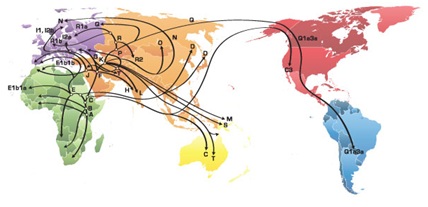Paternal ancestral origins DNA testing
A paternal ancestry origins test is a great way to discover your ancient ancestry on your father’s side of the family. Yes, a paternal ancestry test is the right test for you if you want to trace your father and forefather’s ancient origins. It is the most accurate but also the only means of knowing your true, ancestral prehistoric roots.
Read A Beginner’s Guide to DNA Ancestry Testing HERE which compares the different types of ancestry DNA tests we offer.
Our ancestry tests, whether paternal lineage or another test we offer, have been used for both curiosity purposes but also by people seeking to learn more about their origins. Often these clients were adopted and unable to access any meaningful information about their real origins. A paternal lineage ancestry test also makes a great gift to your father, a male relative or anyone you know who takes an interest in their ancestry and genealogy. The price for the Paternal Lineage Test is CHF169.
Your results will be ready in 4 – 5 weeks via email.


The Y chromosome and your paternal ancestry
The Y chromosome contains all the information about your paternal ancestry. Deeply encoded in very specific regions of your DNA is some very revealing information about your ancient forefathers. A scientific analysis using advanced technology and large database records of ancestral DNA profiles helps us provide you with the most broad paternal lineage test possible.
The Y chromosome is inherited from father to son and passed down from generation to generation. Males from the same lineage will have the same Y chromosome profiles.
Your paternal ancestry test result will:
- Show you your paternal haplogroup affiliation. All humans belong to a haplogroup or big branches in your ancient family tree. Our result it will link you to those ancient forefathers and your ancestral clans with which you share most genetic similarities.
- To help you understand things more clearly and at a deeper level, you will have a detailed explanation of the haplogroup to which you belong.
- A high resolution certificate we provide is great to visualize and trace your forefather’s movement out of the great African continent to other parts of Europe, Asia and the rest of the globe.
There are a total of 19 major Y-DNA haplogroups. View the list of paternal haplogroups and understand more about the characteristics of each.
Can females too discover their paternal ancestry?
Genetically speaking, we all know that females have 23 pairs of XX chromosomes; meaning they have a total of 46 X chromosomes. Paternal lineage testing requires an analysis of certain regions on the Y chromosome where information about our paternal ancestry is encoded. We can thus conclude that females cannot directly, themselves, carry out a paternal lineage test as they do not have a Y chromosome. If a female does wish to learn more about her ancient forefathers, their geographical origins and their migrations patterns, all she needs to do is ask a directly blood male relative (for example a paternal uncle) to take the test on her behalf.
How is the test carried out?
This test uses a method of DNA analysis which we call short tandem repeat analysis. We basically look for repeated sequences or units on your DNA; these units are of course inconceivably tiny and range from 2-6 bp in length. We then look for the number of these very same repeats on your DNA. People with different ancestries will have different repeats on their DNA. STR testing is in fact often used in forensic investigations and of course, for ancestry DNA testing.
From your end, you do not really have to think too much about the complexities of DNA analysis. All you need to do is collect a DNA sample using our home kit. Return the sample back to us and we will do the rest.



 Ancestry Tests
Ancestry Tests